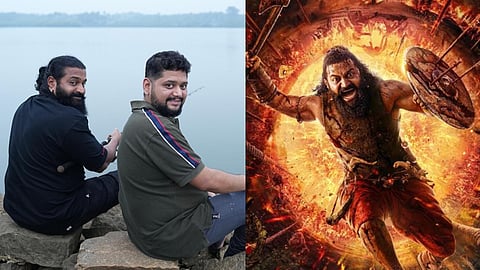

While Ajaneesh B Loknath’s music for Kantara (2022) had already enchanted listeners—especially with the devotional favourite 'Varaharoopam'—the release of the first track from Kantara: Chapter 1, 'Brahmakalasha', has set a resonant tone. It blends classical depth with cinematic grandeur and has sparked the right anticipation just days ahead of the film's release on October 2.
“I am glad that 'Brahmakalasha' has kicked off the film on the right note. The song will gain a deeper meaning once the film is released,” says Ajaneesh. For a story set a thousand years ago, he explains, the music had to feel organic. “We focused on ancient instruments—veena, mrudanga, nadaswaram—and the aalapam in the opening reflects Carnatic traditions. The music was carefully organised to blend Carnatic music with tribal rhythms, researched and presented through the Viruttam style. Brahmakalasha illustrates the process of the kumbha abhishekam, and though every community honours Lord Shiva, tonalities and expressions of devotion vary. This is reflected in the lyrics and composition.”
Ajaneesh credits Rishab Shetty for shaping the musical vision. “When Rishab began Kantara, expectations were high for both the story and its music. He was behind 'Varaharoopam' in the original and now 'Brahmakalasha' in Kantara: Chapter 1. The sound is entirely aligned with his vision. It’s what the director has created, and I simply translated that into music.”
The film consists of four songs, including a melodic number, a track on Karma, and a song glimpsed in the trailer. “There’s no direct reference for these songs, and they are born entirely from the visuals and situations,” Ajaneesh notes. “It was fascinating to study how music existed 1,000 years ago, before Carnatic music was fully organised. Mantras inspired our compositions as well. There’s depth in 'Brahmakalasha', and similar research went into the other tracks, blending Carnatic with folk traditions. Temple musicians and Carnatic classical experts helped us maintain authenticity, preserving sounds passed down through generations.”
On the background score, Ajaneesh emphasises restraint and authenticity. “The scale and grandeur of Kantara: Chapter 1 demanded music rooted in the land and folk traditions. Character arcs and geography shaped the compositions. Overall, the film is a collective experience where story, visuals, direction, and music converge. We aimed to bring Rishab’s vision to life through sound while keeping it anchored to its cultural and historical context.”
Comparing this to the original Kantara, Ajaneesh says the workload was similar, but the expectations for the prequel have been tenfold. “Same work, higher stakes. I especially enjoyed creating Brahmakalasha, which is ancient and layered. It has Sanskrit, Tulu, and Kannada lyrics, complemented by traditional instruments. Credit also goes to producer Vijay Kirangadur and Rishab Shetty, who provided everything needed for the music to flourish.”
It felt almost divine, as if God guided us to create the music for Kantara Chapter 1: Bobby CR
Bobby CR, who worked closely with Ajaneesh, shares, “Working with him and the makers is about aligning with the director’s vision. As a composer, understanding the pulse of the film is essential. Ajaneesh’s first task is always to sync with Rishab’s tempo, the heartbeat of the narrative.”
She adds, “While working, it felt almost divine, as if God guided us to create the music. Only a director like Rishab could craft a story like this, and he has managed to bring an ancient, authentic, rooted story to life. Vijay Kirangadur’s support ensured the project’s vision reached beyond local audiences to a global stage. This collaboration was driven by a unique energy—a rare synergy between director, composer, and production team—that shaped every note and nuance in the soundtrack.”